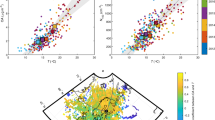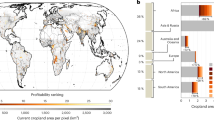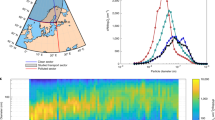Abstract
Cropland expansion has been the most notable change in global land use since industrialization. However, assessments of radiative forcing from land-use change have generally neglected the effects of cropland expansion on secondary organic aerosol. Here we perform a series of cropland expansion sensitivity experiments with an Earth system model that incorporates advanced secondary organic aerosol processes, including organic new particle formation. Our model results show an ~ 10% decrease in biogenic secondary organic aerosol burden due to cropland expansion since industrialization. This has reduced radiation scattering and cloud droplet formation associated with secondary organic aerosol, leading to a 146 ± 112 mW m−2 decline in its radiative cooling forcing, equivalent to 8% of CO2-induced radiative warming forcing since industrialization. The radiative impact is mainly attributed to the transition from evergreen and deciduous broadleaf forests to croplands. The radiative impacts are projected to increase by approximately 50% under future climate warming and reduced anthropogenic aerosol and precursor gas emissions, due to changes in biogenic emission intensity and background cloud condensation nuclei concentration. Policies addressing food security and climate change should account for the radiative impact of biogenic secondary organic aerosol from cropland expansion.
This is a preview of subscription content, access via your institution
Access options
Access Nature and 54 other Nature Portfolio journals
Get Nature+, our best-value online-access subscription
27,99 € / 30 days
cancel any time
Subscribe to this journal
Receive 12 print issues and online access
269,00 € per year
only 22,42 € per issue
Buy this article
- Purchase on SpringerLink
- Instant access to full article PDF
Prices may be subject to local taxes which are calculated during checkout



Similar content being viewed by others
Data availability
All model outputs used in this paper are available via Zenodo at https://doi.org/10.5281/zenodo.13777077 (ref. 49). Source data are provided with this paper.
Code availability
The updated CESM/IMPACT model code are available via Zenodo at https://doi.org/10.5281/zenodo.13777077 (ref. 49).
References
Taylor, C. A. & Rising, J. Tipping point dynamics in global land use. Environ. Res. Lett. 16, 125012 (2021).
Ramankutty, N., Evan, A. T., Monfreda, C. & Foley, J. A. Farming the planet: 1. geographic distribution of global agricultural lands in the year 2000. Glob. Biogeochem. Cycles https://doi.org/10.1029/2007gb002952 (2008).
Potapov, P. et al. Global maps of cropland extent and change show accelerated cropland expansion in the twenty-first century. Nat. Food 3, 19–28 (2022).
Transforming Our World: The 2030 Agenda for Sustainable Development, 21 October 2015, A/RES/70/1 (UN General Assembly, 2015).
Ellison, D. et al. Trees, forests and water: cool insights for a hot world. Glob. Environ. Change 43, 51–61 (2017).
Devaraju, N., Bala, G. & Modak, A. Effects of large-scale deforestation on precipitation in the monsoon regions: remote versus local effects. Proc. Natl Acad. Sci. USA 112, 3257–3262 (2015).
Lawrence, D. & Vandecar, K. Effects of tropical deforestation on climate and agriculture. Nat. Clim. Change 5, 27–36 (2014).
Portmann, R. et al. Global forestation and deforestation affect remote climate via adjusted atmosphere and ocean circulation. Nat. Commun. 13, 5569 (2022).
Li, Y., Piao, S., Chen, A., Ciais, P. & Li, L. Z. X. Local and teleconnected temperature effects of afforestation and vegetation greening in China. Natl Sci. Rev. 7, 897–912 (2020).
Alkama, R. & Cescatti, A. Biophysical climate impacts of recent changes in global forest cover. Science 351, 600–604 (2016).
Betts, R. A., Falloon, P. D., Goldewijk, K. K. & Ramankutty, N. Biogeophysical effects of land use on climate: model simulations of radiative forcing and large-scale temperature change. Agric. For. Meteorol. 142, 216–233 (2007).
Peng, S. S. et al. Afforestation in China cools local land surface temperature. Proc. Natl Acad. Sci. USA 111, 2915–2919 (2014).
Cerasoli, S., Yin, J. & Porporato, A. Cloud cooling effects of afforestation and reforestation at midlatitudes. Proc. Natl Acad. Sci. USA 118, e2026241118 (2021).
Bright, R. M. et al. Local temperature response to land cover and management change driven by non-radiative processes. Nat. Clim. Change 7, 296–302 (2017).
Li, Y. et al. Local cooling and warming effects of forests based on satellite observations. Nat. Commun. 6, 6603 (2015).
Alkama, R. et al. Vegetation-based climate mitigation in a warmer and greener World. Nat. Commun. 13, 606 (2022).
Scott, C. E. et al. The direct and indirect radiative effects of biogenic secondary organic aerosol. Atmos. Chem. Phys. 14, 447–470 (2014).
Weber, J. et al. Chemistry-albedo feedbacks offset up to a third of forestation’s CO2 removal benefits. Science 383, 860–864 (2024).
Unger, N. Human land-use-driven reduction of forest volatiles cools global climate. Nat. Clim. Change 4, 907–910 (2014).
Vella, R. et al. Land use change influence on atmospheric organic gases, aerosols, and radiative effects. EGUsphere 2024, 1–24 (2024).
Guenther, A. B. et al. The model of emissions of gases and aerosols from nature version 2.1 (MEGAN2.1): an extended and updated framework for modeling biogenic emissions. Geosci. Model Dev. 5, 1471–1492 (2012).
Shrivastava, M. et al. Global transformation and fate of SOA: implications of low-volatility SOA and gas-phase fragmentation reactions. J. Geophys. Res. Atmos. 120, 4169–4195 (2015).
Zhao, D. F. et al. Environmental conditions regulate the impact of plants on cloud formation. Nat. Commun. 8, 14067 (2017).
Wang, H., Liu, X., Wu, C. & Lin, G. Regional to global distributions, trends, and drivers of biogenic volatile organic compound emission from 2001 to 2020. Atmos. Chem. Phys. 24, 3309–3328 (2024).
Chen, J., Tang, J. & Yu, X. Environmental and physiological controls on diurnal and seasonal patterns of biogenic volatile organic compound emissions from five dominant woody species under field conditions. Environ. Pollut. 259, 113955 (2020).
Kenseth, C. M. et al. Particle-phase accretion forms dimer esters in pinene secondary organic aerosol. Science 382, 787–792 (2023).
Shrivastava, M. et al. Recent advances in understanding secondary organic aerosol: implications for global climate forcing. Rev. Geophys. 55, 509–559 (2017).
Scott, C. E. et al. Impact on short-lived climate forcers increases projected warming due to deforestation. Nat. Commun. 9, 157 (2018).
Zhu, J. et al. Decrease in radiative forcing by organic aerosol nucleation, climate, and land use change. Nat. Commun. 10, 423 (2019).
Zhao, B. et al. High concentration of ultrafine particles in the Amazon free troposphere produced by organic new particle formation. Proc. Natl Acad. Sci. USA 117, 25344–25351 (2020).
Roldin, P. et al. The role of highly oxygenated organic molecules in the Boreal aerosol–cloud–climate system. Nat. Commun. 10, 4370 (2019).
Kirkby, J. et al. Ion-induced nucleation of pure biogenic particles. Nature 533, 521–526 (2016).
Riccobono, F. et al. Oxidation products of biogenic emissions contribute to nucleation of atmospheric particles. Science 344, 717–721 (2014).
Lund, M. T., Rap, A., Myhre, G., Haslerud, A. S. & Samset, B. H. Land cover change in low-warming scenarios may enhance the climate role of secondary organic aerosols. Environ. Res. Lett. https://doi.org/10.1088/1748-9326/ac269a (2021).
Dada, L. et al. Role of sesquiterpenes in biogenic new particle formation. Sci. Adv. 9, 14 (2023).
Sanaei, A. et al. Changes in biodiversity impact atmospheric chemistry and climate through plant volatiles and particles. Commun. Earth Environ. 4, 445 (2023).
Curtius, J. et al. Isoprene nitrates drive new particle formation in Amazon’s upper troposphere. Nature 636, 124–130 (2024).
Winkler, K., Fuchs, R., Rounsevell, M. & Herold, M. Global land use changes are four times greater than previously estimated. Nat. Commun. 12, 2501 (2021).
Ito, A., Sillman, S. & Penner, J. E. Effects of additional nonmethane volatile organic compounds, organic nitrates, and direct emissions of oxygenated organic species on global tropospheric chemistry. J. Geophys. Res. Atmos. 112, 21 (2007).
Lin, G., Penner, J. E., Sillman, S., Taraborrelli, D. & Lelieveld, J. Global modeling of SOA formation from dicarbonyls, epoxides, organic nitrates and peroxides. Atmos. Chem. Phys. 12, 4743–4774 (2012).
Lin, G., Sillman, S., Penner, J. E. & Ito, A. Global modeling of SOA: the use of different mechanisms for aqueous-phase formation. Atmos. Chem. Phys. 14, 5451–5475 (2014).
Zhu, J. et al. Mechanism of SOA formation determines magnitude of radiative effects. Proc. Natl Acad. Sci. USA 114, 12685–12690 (2017).
Zhang, X. et al. Formation and evolution of molecular products in alpha-pinene secondary organic aerosol. Proc. Natl Acad. Sci. USA 112, 14168–14173 (2015).
Saunders, S. M., Jenkin, M. E., Derwent, R. G. & Pilling, M. J. Protocol for the development of the master chemical mechanism, MCM v3 (part A): tropospheric degradation of non-aromatic volatile organic compounds. Atmos. Chem. Phys. 3, 161–180 (2003).
Zhu, J. & Penner, J. E. Global modeling of secondary organic aerosol with organic nucleation. J. Geophys. Res. Atmos. 124, 8260–8286 (2019).
Lin, G. X. et al. Radiative forcing of organic aerosol in the atmosphere and on snow: effects of SOA and brown carbon. J. Geophys. Res. Atmos. 119, 7453–7476 (2014).
Oleson, K. W. Technical description of version 4.0 of theCommunity Land Model (CLM). NCAR Tech. Note (University Corporation for Atmospheric Research, 2010).
Lawrence, D. M. et al. Parameterization improvements and functional and structural advances in version 4 of the Community Land Model. J. Adv. Model. Earth Syst. 3, M03001 (2011).
Zhu, J. Global warming effects of cropland expansion by reduction of biogenic secondary organic aerosols. Zenodo https://doi.org/10.5281/zenodo.13777077 (2024).
Acknowledgements
This study was supported by the National Natural Science Foundation of China (grants 42221001 and 42177082) and the National Key R&D Plan (grant no. 2022YFE0135000).
Author information
Authors and Affiliations
Contributions
J.Z., J.E.P. and P.F. designed the study and experiments. J.Z. performed model development and execution. J.Z., H.L., X.Z. and J.D. contributed to data analysis. J.Z. wrote the original manuscript. J.Z., C.H., C.-Q.L., Q.Z. and P.F. contributed to improve the manuscript.
Corresponding authors
Ethics declarations
Competing interests
The authors declare no competing interests.
Peer review
Peer review information
Nature Geoscience thanks the anonymous reviewer(s) for their contribution to the peer review of this work. Primary Handling Editor: Thomas Richardson, in collaboration with the Nature Geoscience team.
Additional information
Publisher’s note Springer Nature remains neutral with regard to jurisdictional claims in published maps and institutional affiliations.
Extended data
Extended Data Fig. 1 Change in land cover fraction.
Changes in the percentage of cover of (a) evergreen broadleaf forests, (b) deciduous broadleaf forests, (c) evergreen needleleaf forests, (d) shrubs, and (e) grasslands to cropland and (f) evergreen broadleaf forests, (g) deciduous broadleaf forests, (h) evergreen needleleaf forests to grassland from pre-industrial times to the 21st century.
Extended Data Fig. 2 Changes in the direct radiative effect of SOA.
Changes in the direct radiative effect of SOA due to the vegetation cover change from (a) evergreen broadleaf forests, (b) deciduous broadleaf forests, (c) evergreen needleleaf forests, (d) shrubs, and (e) grasslands to cropland as well as due to the vegetation cover change in (f) high latitudes, (g) middle latitudes and (h) low latitudes in EX_BASE experiment.
Extended Data Fig. 3 Changes in the indirect radiative effect of SOA.
Changes in the indirect radiative effect of SOA due to the vegetation cover change from (a) evergreen broadleaf forests, (b) deciduous broadleaf forests, (c) evergreen needleleaf forests, (d) shrubs, and (e) grasslands to cropland as well as due to the vegetation cover change in (f) high latitudes, (g) middle latitudes and (h) low latitudes in EX_BASE experiment.
Extended Data Fig. 4 Changes in the total radiative effect of SOA.
Changes in the total radiative effect (DRE + IRE) of SOA due to the change in vegetation cover from pre-industrial times to the 21st century in EX_BASE experiment.
Supplementary information
Supplementary Information
Supplementary Figs. 1–9, Table 1 and Text 1.
Source data
Source Data Fig. 1
Data for the percentage of global vegetation cover type from 1850 to the twenty-first century.
Source Data Fig. 2
Data for the contribution of each vegetation cover change process to BVOC emissions, SOA and radiative effects.
Source Data Fig. 3
Data for changes in the radiative effect of SOA varied with latitudes.
Rights and permissions
Springer Nature or its licensor (e.g. a society or other partner) holds exclusive rights to this article under a publishing agreement with the author(s) or other rightsholder(s); author self-archiving of the accepted manuscript version of this article is solely governed by the terms of such publishing agreement and applicable law.
About this article
Cite this article
Zhu, J., Penner, J.E., Hong, C. et al. Cropland expansion reduces biogenic secondary organic aerosol and associated radiative cooling. Nat. Geosci. (2025). https://doi.org/10.1038/s41561-025-01718-z
Received:
Accepted:
Published:
DOI: https://doi.org/10.1038/s41561-025-01718-z



